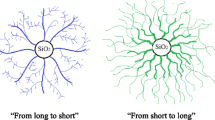Abstract
Colloidal silica particles in organic solvents were grafted, using several reagents, in order to make them hydrophobic. The hydrophobicity of the beads could be easily varied. Quasielastic light scattering and transmission electron microscopy experiments showed that no aggregation occurs during the reaction when monofunctional agents are used. Elemental analysis and solid-state NMR measurements gave us the rate of surface modification of the silanol groups. We also studied the rheological behaviour of the grafted particles as a function of the volume fraction in solvents of various hydrophobicity. Hexamethyldisilazane-grafted particles display hard-sphere behaviour in polar solvents such as 2-propanol, but not in alkanes, whereas dimethyldodecylchlorosilane-grafted particles flocculated in polar solvents but could easily be dispersed in apolar solvents.
Similar content being viewed by others
Author information
Authors and Affiliations
Additional information
Received: 15 March 2000 Accepted: 11 July 2000
Rights and permissions
About this article
Cite this article
Poncet-Legrand, C., Bordes, B. & Lafuma, F. Surface modification of colloidal silica particles. Colloid Polym Sci 279, 114–121 (2001). https://doi.org/10.1007/s003960000391
Issue Date:
DOI: https://doi.org/10.1007/s003960000391




